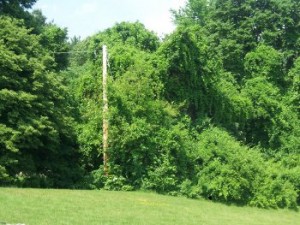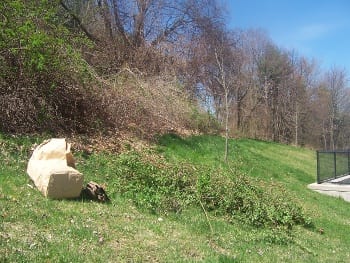by Rebecca Chizzo
The Sudbury Weed Education and Eradication Team (S.W.E.E.T.) was established in August 2009 to make people aware of the harm that invasive plant species do to our historic and environmentally sensitive natural areas and parks. A second goal of the organization was to encourage responsible removal of invasive plants. Along with area residents and a Boston University graduate student, we selected removal sites within the town of Sudbury with the guidance of the Town of Sudbury Conservation Commission and secured funding for initial start-up from the Sudbury Assabet Concord Watershed and the Cooperative Invasive Management Area (SuAsCoCISMA).
Beginning at the Sudbury Town Center, the newly formed group began to tackle three and a half feet of Oriental Bittersweet and Multiflora Rose growing behind the Town Hall and the northern Revolutionary Cemetery War walls and Animal Pound. We felt the importance of the site and high visibility would help residents see that something should and could be done about invasive plants. Joined by four additional residents, the group retained the assistance of the New England Wild Flower Society for a cutting and application program for the large roots that remained in the walls and could not be removed manually without damage to the site.

Summer 2006: Large Lindens are totally covered by a 50 foot Oriental bittersweet and a 30 foot Multiflora rose.

August 2011: After two years of cutting, root wrenching, and brush mowing,a Linden remains free of invasives.
After operating for a three-year period, S.W.E.E.T. consists of a core group of five and a dozen repeat volunteers. Provided with support and guidance from outside organizations, we’ve become a small, but effective working team. S.W.E.E.T. currently has members who are involved in planning and outreach activities and have overseen work party groups up to 29 persons. More frequently, work is done by individuals or by small groups of two to five. Many more resident and student volunteers are required in order to achieve the level of progress needed to combat the massive and fast growing populations of invasive species in the community.
Expanding Removal Projects
S.W.E.E.T. is part of a private-public partnership taking place in the King Phillip Woodlands Conservation area just off Water Row Road and Route 27. The Town of Sudbury Conservation Commission proposed and received funding in 2010 and 2011 from the State of Massachusetts for removal of invasive plants and remediation of this important historic and conservation area. S.W.E.E.T. has committed to work in this location to reduce the proliferation of invasive plant species presenting threats to the varied native trees, wetlands, vernal pools, ponds, and bog habitats. Oriental Bittersweet, Exotic Bush Honeysuckles, Multiflora Rose, and European Buckthorn are the targeted species.
For one of its earliest projects, S.W.E.E.T. founders offered and gained acceptance for a cooperative plan to tackle the invasive populations of the Lincoln Sudbury High School large wooded property with the Building and Grounds Coordinator and the Sudbury Conservation Coordinator. Students have chosen to work with group members to remove invasive plants and improve selected sites. Individuals earn community service hours towards graduation for service with the group. Part of the S.W.E.E.T founders’ focus is school community awareness and fostering long term relationships with area school teachers and administrators to provide suitable student work and service opportunities.
The S.W.E.E.T. work properties now include Lincoln Sudbury Regional High School (7 areas), Heritage, Fetherland and Feeley Parks, Sudbury Town Center, Goodnow Public Library, and King Phillip Conservation Woodlands. Within the park, school and historic properties are opportunities for surveys, bridge work, removals, new plantings, trail clearing and improvements.
For 2012, S.W.E.E.T. proposals were accepted by the Sudbury Assabet Concord Wild and Scenic Rivers small grants program with separate funds from an employee year-end giving program from Math Works.
Education Initiatives
In addition to organizing invasives removal, S.W.E.E.T. works to educate the public and students. We conduct presentations and install displays in school and library settings as well as community fairs with a custom approach. We try to determine what will reach and appeal to the intended audience. The group has a “what can we do for you?” attitude in all field and outreach projects. To support our outreach efforts, we maintain a bank of 600-800 photographs; real plant displays; take home identification materials; and invasive plant coloring sheets.
We gained community visibility in 2011, when we held the first annual Garlic Mustard Pull in Sudbury, patterned after a “resident pull” in nearby Lincoln, MA. Garlic mustard (Allaria Petiolata) is a harmful biennial herb plant from Eastern Europe which was brought with immigrants to America starting in the 1800s. The new herb was readily accepted and planted in small farms. If collected in the spring, the leaves of this plant can be used in stir fries, soups, casseroles, and sauces.
However, there are no natural controls for garlic mustard in our area and the alien species escaped cultivation and multiplied. Garlic Mustard patches that were ignored continued to spread rapidly. Now, in May, groups of these plants are often seen in white flowering populations along roadways. The tiny seeds are picked up and carried to new places from foot or auto traffic, regular maintenance, development, and wildlife corridor movement. New populations then infest previously garlic mustard free land.
Controlling Garlic Mustard
Adding to garlic mustard dominance over native plants, the roots of this banned species exude a substance that changes the fungus in soil to one it prefers. Native tree seedlings, especially pine, either do not survive the alteration or are overtaken by the fast growing invasive. Garlic mustard in the second year bolts with a stalk up to three feet tall. There is really no limit to the size of the leaves. They therefore block light from and smother understory seedlings and ground dwelling native plants.
The good news is that pulling populations of this invasive plant species for five to seven years can exhaust the seed banks and reduce or eliminate the damage which the plants can do to our woodlots, parks, and important conservation and community sites.
Finding that Sudbury had growing populations of this banned species, S.W.E.E.T. responded with a community event. We created signs, publications, and flyers; and asked for help for on-line education and notice from Sudbury Valley Trustees, the Town of Sudbury Conservation Commission and K-8 Town of Sudbury Schools administrators. The Historical Commission and Department of Public Works supported the event with a meeting location for residents at the Hosmer House and disposal of the collections. Over a one-month period, 99 sites were found, reported, and confirmed; and participants collected 222 bags of garlic mustard. The group was allowed to pull plants within the road side five-foot buffers and on conservation sites in addition to the previously approved park and historic locations
Sudbury’s 2012 Garlic Mustard Pull began April 28 and ended on May 20. Sudbury resident groups responded this spring by pulling 714 bags of these harmful plants – more than tripling the amount of plant material removed.
This year, the S.W.E.E.T extended the idea to Wayland, MA, and in the future, Lincoln, Sudbury and Wayland plan to coordinate concurrent weed pulls. We continue to reach out to individuals and organizations with similar interests in offering education about invasive plants and in promoting removal projects.
Invasives Listing
S.W.E.E.T.’s list of targeted plants and their native ranges:
Oriental Bittersweet (Eurasia)
Garlic Mustard (Eastern Europe)
Multiflora Rose (Japan/Korea)
Common and Glossy Buckthorn (Europe and parts of Africa)
Purple Loosestrife (Japan, parts of Europe and China)
European “Bittersweet” Nightshade (Europe)
Exotic Bush and Japanese Honeysuckle (Eurasia, Japan)
Black Locust (native of North America- invasive in the state)
Norway Maple (Europe)
Japanese Knotweed (Japan)
Common and Japanese Barberry (Eurasia, Korea, Japan)
Autumn Olive (Afghanistan- Eurasia, Japan, Korea)
Phragmites (Africa, Europe)
Cypress and Leafy Spurge (Eurasia)
Black/Pale Swallowwort (Mediterranean)
The group is aware of other plants, such as Mile-a-Minute, which are of concern but not currently found in our community, and includes awareness and early detection in their outreach efforts.
About the Author
Rebecca Chizzo founded and organized S.W.E.E.T. and actively works to control invasive species in Sudbury, MA while simultaneously educating residents about the threat of invasives. S.W.E.E.T. seeks volunteers with different perspectives and skill sets to help with education and public outreach efforts. To offer help, contact Rebecca at (978)505-1301 or email the group at SWEETinvasives@gmail.com.


